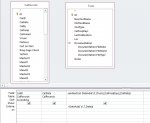Hello!
Hey guys. I am pretty new at Access, so bear with me a little.
I have designed a database that is for calibration of all of our in-house tools. With this, I would like to add a report function that tells me what is due in the next week. I have one Table that contains all of the calibration records (tool ID, calibration date, and so fourth) and another table that is a master list of all of the tools. This table contains Tool location on the production floor, Tool Type, Calibration cycle length (in days) among other things. For ease of entry, most of my database items are lookup table values. This locks the person entering the information in to a set of pre-defined values. (calibration schedules being pulled from a table that contains amount of days for each schedule (daily,1; weekly,7; monthly,30; bi-monthly,60, etc)
What I need to do is take the default cycle length, add that to the date of last calibration, and print a report that shows tool ID, last calibration date, due date (calculated and never stored in the table), and location of the tool. I have this working, to a point....
So far, I have a sub query that pulls the correct info, and does a date calculation.
For the life of me, I cannot figure out why it returns multiple records. It should only show one tool, the date it was calibrated, the day it's due. But I am getting multiple results. I know I'm going to have to add a filter for only showing the last time a tool was calibrated (that's a fight for another day), but at this stage of the development, there is only one calibration record per tool.
I have attached a screenie to show what my query is set up like. If anyone can help me, I would really appreciate it.
Hey guys. I am pretty new at Access, so bear with me a little.
I have designed a database that is for calibration of all of our in-house tools. With this, I would like to add a report function that tells me what is due in the next week. I have one Table that contains all of the calibration records (tool ID, calibration date, and so fourth) and another table that is a master list of all of the tools. This table contains Tool location on the production floor, Tool Type, Calibration cycle length (in days) among other things. For ease of entry, most of my database items are lookup table values. This locks the person entering the information in to a set of pre-defined values. (calibration schedules being pulled from a table that contains amount of days for each schedule (daily,1; weekly,7; monthly,30; bi-monthly,60, etc)
What I need to do is take the default cycle length, add that to the date of last calibration, and print a report that shows tool ID, last calibration date, due date (calculated and never stored in the table), and location of the tool. I have this working, to a point....
So far, I have a sub query that pulls the correct info, and does a date calculation.
For the life of me, I cannot figure out why it returns multiple records. It should only show one tool, the date it was calibrated, the day it's due. But I am getting multiple results. I know I'm going to have to add a filter for only showing the last time a tool was calibrated (that's a fight for another day), but at this stage of the development, there is only one calibration record per tool.
I have attached a screenie to show what my query is set up like. If anyone can help me, I would really appreciate it.

